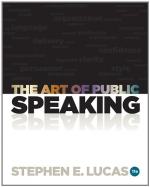Your throat should be free from strain during speech, therefore it is necessary to avoid muscular contraction. The throat must act as a sort of chimney or funnel for the voice, hence any unnatural constriction will not only harm its tones but injure its health.
Nervousness and mental strain are common sources of mouth and throat constriction, so make the battle for poise and self-confidence for which we pleaded in the opening chapter.
But how can I relax? you ask. By simply willing to relax. Hold your arm out straight from your shoulder. Now—withdraw all power and let it fall. Practise relaxation of the muscles of the throat by letting your neck and head fall forward. Roll the upper part of your body around, with the waist line acting as a pivot. Let your head fall and roll around as you shift the torso to different positions. Do not force your head around—simply relax your neck and let gravity pull it around as your body moves.
Again, let your head fall forward on your breast; raise your head, letting your jaw hang. Relax until your jaw feels heavy, as though it were a weight hung to your face. Remember, you must relax the jaw to obtain command of it. It must be free and flexible for the moulding of tone, and to let the tone pass out unobstructed.
The lips also must be made flexible, to aid in the moulding of clear and beautiful tones. For flexibility of lips repeat the syllables, mo—me. In saying mo, bring the lips up to resemble the shape of the letter O. In repeating me draw them back as you do in a grin. Repeat this exercise rapidly, giving the lips as much exercise as possible.
Try the following exercise in the same manner:
Mo—E—O—E—OO—Ah.
After this exercise has been mastered, the following will also be found excellent for flexibility of lips:
Memorize these sounds indicated (not the expressions) so that you can repeat them rapidly.
| A as in May. | E as in Met. | U as in Use. | A " Ah. | I " Ice. | Oi " Oil. | A " At. | I " It. | Ou " Our. | O " No. | O " No. | OO " Ooze. | A " All. | OO " Foot. | A " Ah. | E " Eat. | OO " Ooze. | E " Eat.
All the activity of breathing must be centered, not in the throat, but in the middle of the body—you must breathe from the diaphragm. Note the way you breathe when lying flat on the back, undressed in bed. You will observe that all the activity then centers around the diaphragm. This is the natural and correct method of breathing. By constant watchfulness make this your habitual manner, for it will enable you to relax more perfectly the muscles of the throat.
The next fundamental requisite for good voice is
2. Openness
If the muscles of the throat are constricted, the tone passage partially closed, and the mouth kept half-shut, how can you expect the tone to come out bright and clear, or even to come out at all? Sound is a series of waves, and if you make a prison of your mouth, holding the jaws and lips rigidly, it will be very difficult for the tone to squeeze through, and even when it does escape it will lack force and carrying power. Open your mouth wide, relax all the organs of speech, and let the tone flow out easily.




